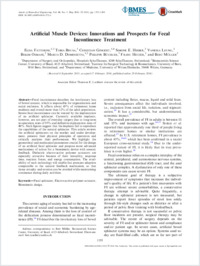Artificial Muscle Devices: Innovations and Prospects for Fecal Incontinence Treatment.
- Fattorini E Department of Surgery and Orthopedics, Hospitals Schaffhausen, 8200, Schaffhausen, Switzerland.
- Brusa T Institute for Surgical Technology & Biomechanics, University of Bern, 3014, Bern, Switzerland.
- Gingert C Department of Surgery and Orthopedics, Hospitals Schaffhausen, 8200, Schaffhausen, Switzerland.
- Hieber SE Biomaterials Science Center, University of Basel, 4123, Allschwil, Switzerland.
- Leung V Biomaterials Science Center, University of Basel, 4123, Allschwil, Switzerland.
- Osmani B Biomaterials Science Center, University of Basel, 4123, Allschwil, Switzerland.
- Dominietto MD Department of Surgery and Orthopedics, Hospitals Schaffhausen, 8200, Schaffhausen, Switzerland.
- Büchler P Institute for Surgical Technology & Biomechanics, University of Bern, 3014, Bern, Switzerland.
- Hetzer F Department of Surgery and Orthopedics, Hospitals Schaffhausen, 8200, Schaffhausen, Switzerland.
- Müller B Biomaterials Science Center, University of Basel, 4123, Allschwil, Switzerland. bert.mueller@unibas.ch.
- 2016-03-02
Published in:
- Annals of biomedical engineering. - 2016
Biomimetic design
Electro-active polymer actuator
Fecal sphincter
Adult
Anal Canal
Artificial Organs
Biomimetic Materials
Fecal Incontinence
Humans
Prosthesis Design
Prosthesis Failure
English
Fecal incontinence describes the involuntary loss of bowel content, which is responsible for stigmatization and social exclusion. It affects about 45% of retirement home residents and overall more than 12% of the adult population. Severe fecal incontinence can be treated by the implantation of an artificial sphincter. Currently available implants, however, are not part of everyday surgery due to long-term re-operation rates of 95% and definitive explantation rates of 40%. Such figures suggest that the implants fail to reproduce the capabilities of the natural sphincter. This article reviews the artificial sphincters on the market and under development, presents their physical principles of operation and critically analyzes their performance. We highlight the geometrical and mechanical parameters crucial for the design of an artificial fecal sphincter and propose more advanced mechanisms of action for a biomimetic device with sensory feedback. Dielectric electro-active polymer actuators are especially attractive because of their versatility, response time, reaction forces, and energy consumption. The availability of such technology will enable fast pressure adaption comparable to the natural feedback mechanism, so that tissue atrophy and erosion can be avoided while maintaining continence during daily activities.
- Language
-
- English
- Open access status
- hybrid
- Identifiers
-
- DOI 10.1007/s10439-016-1572-z
- PMID 26926695
- Persistent URL
- https://sonar.ch/global/documents/155292
Statistics
Document views: 29
File downloads:
- fulltext.pdf: 0
